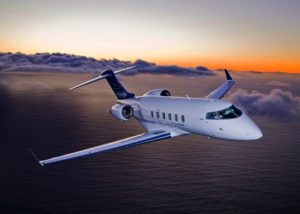Gulfstream G280 versus Challenger 350: A “Fly-off” Comparison

A glimpse of the Gulfstream G280 in action.
In the spring of 2017 I was invited by Gulfstream’s Sales Director in New England, Jeff Cole, to a comparison of the Gulfstream G280 versus the Bombardier Challenger 350. Impressed by the accommodating nature of the Gulfstream employees and the way they refrained from bad-mouthing their competition, I feel it was a very fair comparison of the two aircraft. We were provided extensive ground briefings and back-to-back flights from Hanscomb Field (BED) in Concord, Massachusetts to State College, Pennsylvania and back.
The two aircraft presented in the comparison were the Gulfstream G280 demonstrator (serial number 80) and a 3 month old Challenger 350. The Gulfstream G280 had about 900 hours of flight time accumulated while the Challenger 350 had about 150 hours. Both were excellent examples of their respective types.
The following is a side-by-side comparison of features based on my observation:
Gulfstream G280 vs. Challenger 350: An Overview

An in-flight view of a Challenger aircraft.
If your first impression of the G280 is a warmed over Galaxy or G200, forget it! This is a new airplane in many important respects. As you look closely, you’ll notice the empennage has been radically redesigned. It now features a T-tail and a very convenient baggage loading door with low sill height under the left engine. You’ll also notice the redesign of the wing, including aerodynamic improvements and bleed air anti-ice on the leading edges.
The Challenger 350 by comparison is a “freshening” of the market segment leading Challenger 300. While very nice design improvements have been incorporated, the 350 is not a radical departure from its predecessor. However, don’t take that as a criticism. Bombardier has no reason to tamper with the aircraft’s success!
A Look at the Interior
The Gulfstream G280’s main entry door staircase leading to the cabin presents well with a low angle of incline since the 280 sits close to the ground. Entry is easy. The Challenger stairway has a greater angle of incline since the aircraft sits higher on its landing gear. In terms of ramp appeal, the Challenger 350 is just plain handsome.
Comparing Cabins
As you enter the G280 cabin, you’ll immediately notice that the selection of the interior materials and the workmanship can best be described as “Gulfstream quality”. According to Gulfstream, the G280’s cabin is “a little over a foot” longer than the Challenger 350, but visually it appeared to be about an 18” advantage. The aft-most passenger seat on the right side has room to recline.
The aisle in the G280 is dropped, while the Challenger enjoys a flat floor throughout the cabin, lavatory and baggage area. However, the drop is only about 5”. If you are comfortable with the aisle in the Hawker series, you would probably not find the G280 aisle objectionable compared to designs with a deeper trough. After a short time in the cabin, the aisle will become a nonevent for most passengers.
The seat bases in both aircraft are solid and articulate nicely. The G280 has a 1” width advantage at 21” versus 20” in the 350, but the 350 has a wider armrest making it slightly more comfortable. The front edge of both seat cushions is 17.5” above the floor (or seat platform in the 280’s case), and for most individuals the seat height is comfortable.
Windows, Water Pumps, and Water Lines
The windows in the G280 are round and well-placed. However, the new windows in the Challenger 350 are a step up from its predecessor, the 300. In comparison, the windows are larger and positioned well in relation to the seat location. Plus, they tend to provide an excellent view for passengers and better ambient light in the daytime versus the 300.
The G280’s galley echoes “Gulfstream quality” with redundant water pumps and lines. In the event one supply freezes or fails (which isn’t an unusual occurrence for any business jet), there is a second water supply to service both galley and lavatory requirements. The 350 may offer a bit more counter space.
A Look at the Lavatories
Gulfstream has done a masterful job of designing the lavatory. The lav is large and really benefits from a window on the right side of the aircraft. Storage is plentiful, and the vacuum toilet is great—particularly for long flights—versus the traditional blue fluid. Note that the entrance door to the baggage area is a secondary pressure bulkhead with some minor restrictions.
While not as luxurious, the lavatory in the Challenger is adequate and functional. Yet passengers spend most of their time in the cabin, not the lavatory. The entrance door to the baggage area is not a secondary pressure bulkhead so it has no restrictions.
Exploring the Avionics
The G280’s Gulfstream heritage is clearly evident in the sophistication of its Rockwell Collins Fusion “PlaneView” avionics system. Autothrottle and autobraking are standard features on the G280 while available avionics options include Heads Up Guidance (HGS) and Enhanced Vision System (EVS II). Synthetic vision is also available for the captain’s side. It’s an avionics package with systems architecture and redundancy that telegraph Gulfstream’s intent to make the G280 capable of international missions.
The Challenger 350’s ProLine 21 Advanced avionics package meets all of the requirements for flying in NextGen airspace either as standard or with typically spec’d options. Synthetic Vision and Multi-scan weather radar are standard. The ProLine Advanced system is reliable and offers easy transition from earlier Rockwell ProLine systems with similar logic. In a word, the system is state-of-the-art in terms of capability.
Comparing Direct Operating Costs
Direct operating costs include fuel, airframe maintenance, and engine/APU restoration. The flight to State College confirmed what all the research materials indicate: the Gulfstream G280 demonstrated excellent fuel burn numbers and appears to have a distinct advantage over the Challenger 350 in fuel consumption. Fuel burn seems to be on par with the Hawker 800XP over similar missions.
Both aircraft are powered by variants of the Honeywell HTF 7000, so the engines and APUs are quite similar—but not identical. Both aircraft are covered by Honeywell’s MSP programs at similar rates.
Additionally, both airframes are covered by the manufacturer’s airframe maintenance programs—PlaneParts in Gulfstream’s case and SmartParts in Bombardier’s case. For those who may not recall, Bombardier pioneered the airframe “power by the hour” concept when it introduced SmartParts in 1986. Competitors then followed.
Bombardier has perfected SmartParts over the decades and Gulfstream offers an attractive program as well. However, there are important differences in the programs that require careful evaluation for a thorough understanding of each program.
In-Flight Observations
I won’t go into performance details. Both aircraft are outstanding performing business jets and performance needs to be evaluated relative to the owner’s intended usage. However, in my opinion the Gulfstream G280 offers a quieter cabin than the Challenger 350, while the Challenger 350 is a stable platform that offers the passengers a very comfortable ride. The large windows in the 350 make the cabin feel spacious.
In Conclusion: Final Thoughts on the Gulfstream G280 vs. the Challenger 350
Both Gulfstream and Bombardier should be justifiably proud of their respective aircraft. Each aircraft enjoys many fine features. Preference will depend upon intended use and several subjective personal factors.
Gulfstream and Bombardier are both credible contenders in this market segment. If you are a super mid-size purchaser, you need to undertake a comprehensive evaluation of both aircraft and the programs behind those aircraft before making your decision.
Again, I wish to thank the Gulfstream sales, marketing, and flight operations team for allowing me to experience this extremely valuable side-by-side comparison. Jeff Cole and his team were outstanding representatives for Gulfstream Aerospace Corporation.
